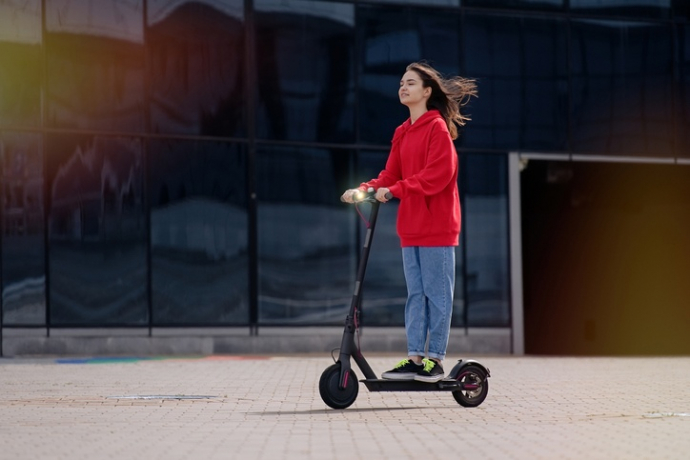
The vast majority of women are unwilling to use e-scooters due to a lack of safe infrastructure.
The new research endorsed by Women in Transport reveals 79 per cent do not feel safe hiring e-scooters to use on the road.
E-scooters remain illegal to use on public roads unless part of the officially sanctioned trials taking place across the country and which run until later this year.

The UK is the last major European economy where e-scooters are still banned to use anywhere except on private land. However, the legal status of e-scooters isn’t stopping them from being bought in huge numbers.
Nobody knows for certain how many e-scooters have been sold in the UK, but Halfords saw its own sales more than double over lockdown and it believes there is huge latent demand. When the retailer polled 2,000 adults, 33% said they’d would consider using an e-scooter for shorter journeys if they became legal to use and 28% would consider swapping their car for an e-scooter to ‘benefit the environment.
Electric scooters and UK law
Under current British law, e-scooter riders face a £300 fixed-penalty notice and six points on their driving licence for using them on the road or pavement. The law classifies e-scooters as motor vehicles, but their legal status is further hampered by the fact they do not have a seat which is currently a requirement of all road going vehicles. That means that with the exception of the various trial schemes dotted around the country, you can’t ride an e-scooter on a public road, on pavements or cycle lanes. You also have to be 18 or over to use one.
When will e-scooters be legal on UK roads?
Following the current e-scooter trials, which run until March 2022, there’s likely to be lengthy discussion over whether to make legal to use on the road. it seems likely that eventually e-scooters will be classified in the same way as electric bicycles. In other words, legal to use on public roads and cycle lanes and with no requirement for registration or insurance, but limited to a speed of 15.5mph. It’s unclear whether helmets will be mandatory as it would hardly be practicable for e-scooter riders to wear motorcycle helmets. There have been concerns raised that a surge in e-scooters would discourage folk from walking or cycling. However credible this argument, it’s more likely that e-scooters will draw drivers from their cars for short trips.
Are e-scooters dangerous?
Department for Transport statistics, Reported Road casualties Great Britain, annual report: 2020, reveal there was one death, 128 serious injuries and 355 slight injuries last year. Given nobody knows how many miles were travelled by e-scooter it’s impossible to quantify the risk associated with riding an e-scooter. However, in common with other vulnerable road users, it’s likely that the main danger faced by e-scooter riders is the drivers of heavier, faster vehicles.
Much faith is being out in electric vehicles, but electrifying cars will not address the problems of traffic congestion, road danger, urban sprawl and wasted space for parking. There’s no doubt that e-scooters have a valuable role to play in coaxing drivers from their cars – the current uncertainty over their future legal status does little more than put that potential on hold.
The ethical choice
The ETA was established in 1990 as an ethical provider of green, reliable travel services. Over 30 years on, we continue to offer cycle insurance , breakdown cover and mobility scooter insurance while putting concern for the environment at the heart of all we do.
The Good Shopping Guide judges us to be the UK’s most ethical provider.

Philip
More gender based nonsense.
E scooters do not belong on UK roads irrespective of gender.
Keith Reeder
It’s not nonsense at all – for those of us who aren’t instantly triggered Daily Mail readers, at any rate.
The two statements are not mutually exclusive: there can indeed be a gender-related imbalance in the numbers of scooter users – that’s just a matter of someone doing some counting; AND E-scooters can be a complete liability with no business on our roads.
Or footpaths and cycleways, for that matter.
Chris
I was nearly run-down by an obnoxious imbecile zooming around a bend on a footpath (i.e. a path officially set aside for pedestrians, away from a road.) If he had blinked or been distracted, he would certainly have hit me.
Torsten
More nonsense.
How many men feel unsafe using them because of poor infrastructure.
Is there any actual evidence from countries that have had them for years (eg Denmark) that people use them instead of the car?
My observation is that it is mostly fit young people who could walk or cycle.
They are often obstacles on pavements and cycle paths and are becoming a major hazard for pedestrians.
Mark
Here in Lisbon we’ve had public and private e-scooters for a couple of years.
There are certainly significant problems (teething problems?) with antisocial riding and antisocial parking that are still being grappled with, but I do think they have the potential to be very beneficial for the city. From the data I’ve seen, they are no more dangerous to riders or others than bicicles, i.e. not dangerous at all, however scary on occasion. As the article says, the danger is from heavier vehicles.
However, we can’t expect them on their own to reduce car use. A study I saw found that while private scooter owners used their cars less, public share scooters replaced walking and public transport.
Doug M
Nothing to do with e-scooters, Mark. The last time I was in Lisbon (many years ago), the normal standard of driving was to go at maximum speed towards the next obstruction (traffic queue or red lights) then apply emergency braking at the last possible moment! Has this changed?